Can Microplastics Be Filtered Out Of Water
 This resource is part of Scientific discipline Friday's Educator Phenomena Forum and was developed collaboratively by Chenille Williams, an educator at the Richland County Department of Public Works, and Timnit Kefela, a Ph.D. candidate at Academy California Davis specializing in microplastics pathways. Click here for a folder of classroom resources.
This resource is part of Scientific discipline Friday's Educator Phenomena Forum and was developed collaboratively by Chenille Williams, an educator at the Richland County Department of Public Works, and Timnit Kefela, a Ph.D. candidate at Academy California Davis specializing in microplastics pathways. Click here for a folder of classroom resources.
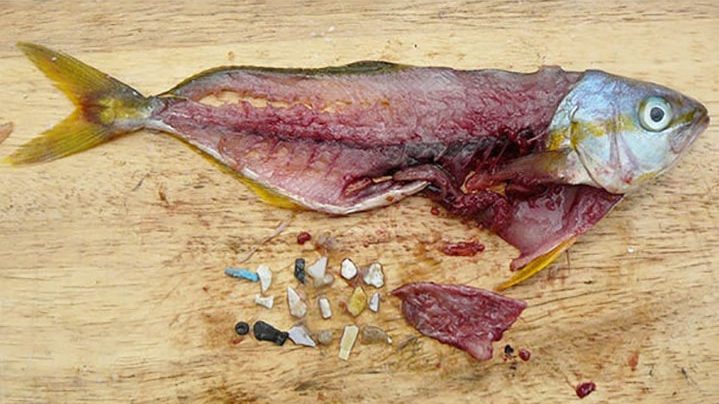
Take a moment to examine the prototype of a Rainbow Runner fish above. What do y'all detect? What do you wonder?
Proceed track of your ideas on the Microplastic Pattern Worksheet.
Now take a wait at the graph below (exist certain to examine all labels). What do you find? What do you wonder?
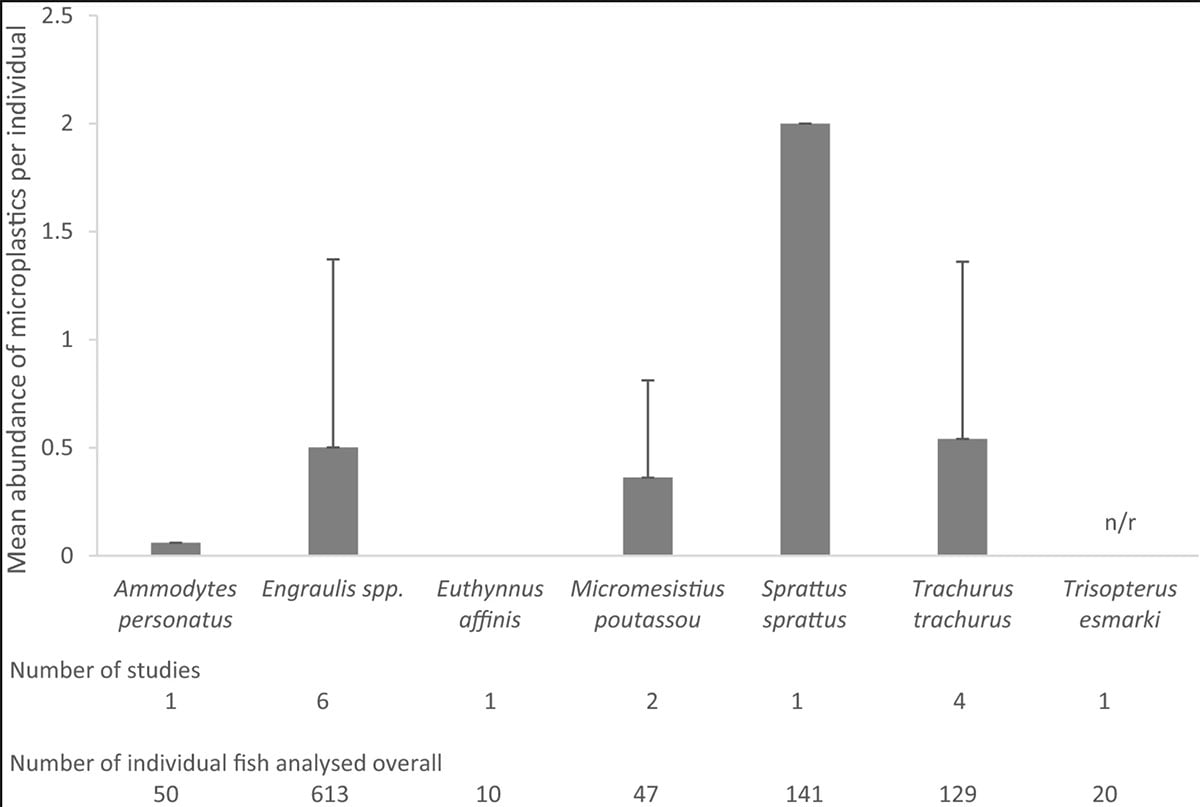
Did you lot notice the plastic in the stomach of that Rainbow Runner above? There were many unlike colors, and those are just the plastic we can see! When you looked at the chart higher up, y'all might have noticed that microplastics are plant in the stomach of many of the fish studied. Undersea animals and fish may consume some strange things, but microplastics should never be on the carte. So how practise microplastics become into the stomach of a fish in the first place?
Brand A Visual Model
Take a moment to call up near that question and create a visual model on your Microplastic Blueprint Worksheet that explains your current ideas virtually where the plastic is from and how it gets into the tum of fish. Exist sure to include labels to assistance communicate your ideas and add together questions where you're unsure.
If you lot tin, work with someone else and compare your models. Are there ideas that you might desire to contain from that word?
Related Segment
Enquire An Expert: What The Heck Are Microplastics?
How Do Microplastics Get Into The Bounding main?
I of the means we can gainsay the "plastic smog"—clouds of microplastics in our oceans—is to preclude microplastics from entering waterways from stormwater runoff. Many major cities, though not all, rain and runoff drain and collect in a bioretention prison cell designed to remove pollutants from the h2o. Unfortunately, microplastics are likewise small to be defenseless, and then when the h2o leaves the bioretention cell for the nearest river, lake, stream, or ocean, information technology carries these tiny, lethal pollutants into the marine nutrient chain.
Let'due south create a model of a bioretention cell to go a ameliorate understanding of how they work, and why pocket-size pollutants like microplastics are hard to trap.
Permit'due south Model A Bioretention Cell
Like we saw in the graph, microplastics of diverse sizes are getting in the ocean and too the ocean food concatenation. Call up about the place y'all live during and after the rain, where is all the water going? Barring completely eliminating plastics, how tin we blueprint a cell that would help us forbid microplastics from getting washed out with that surface runoff? We can use a physical model to help us empathize more almost the trouble before trying to develop a solution.
Materials
16-oz plastic bottle
X-acto pocketknife or precipitous pair of scissors (Warning: X-acto knives are precipitous! Please use under adult supervision or take an adult help yous cut your materials.)
Soil
Gravel or pebbles
Aluminum tray
Glitter (or seed beads)
Water
Window screen squares
Cup
Bioretention Jail cell Building Protocol
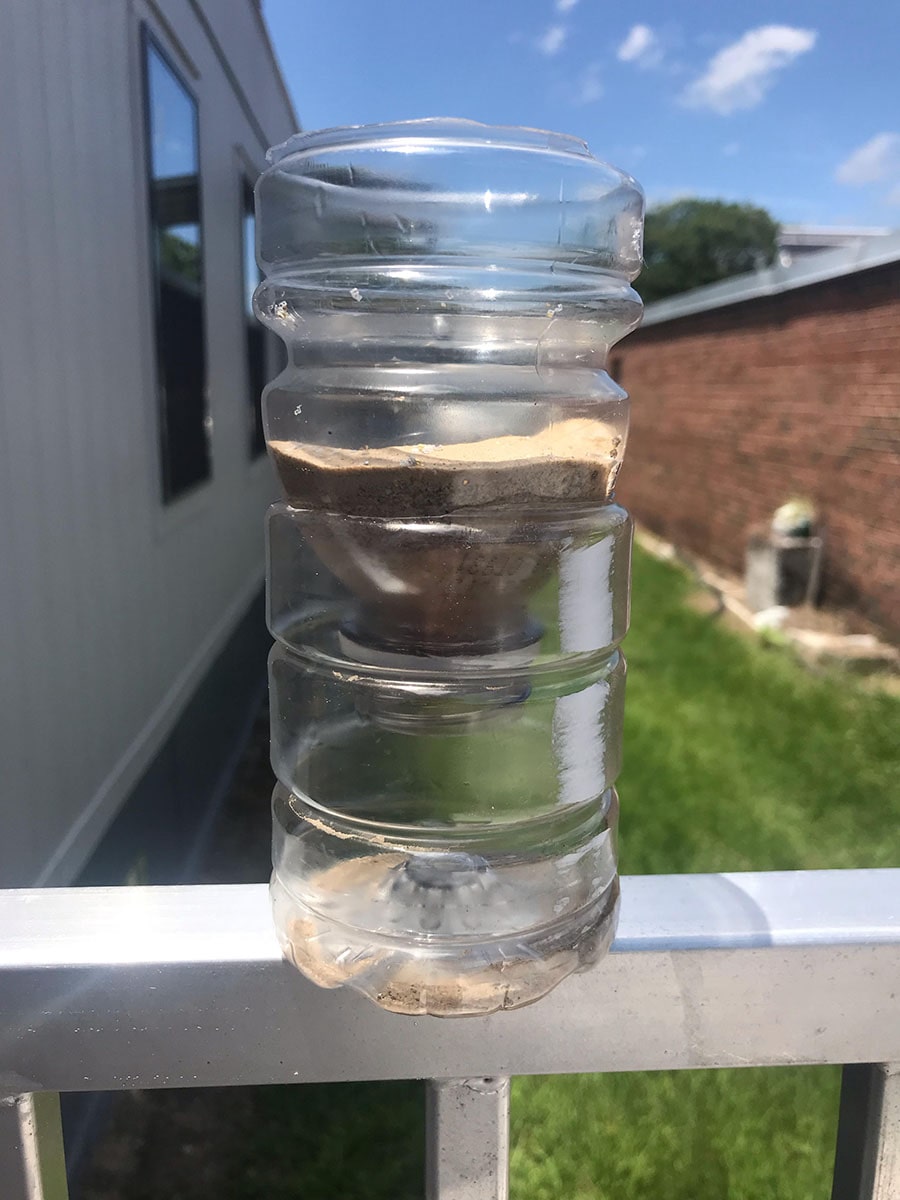
- Cut the water bottles in half.
- Cut a small hole halfway down the superlative half of each plastic canteen.
- Place the window screen in the top one-half of each plastic bottle, where the mouth is located.
- Make full half of the top half of 1 bottle with soil and the other bottle with gravel.
- Remove the cap and identify the superlative half of each h2o canteen, mouth-end down, inside the lesser half.
- Place the two halves of the water bottles inside the aluminum tray.
- Mix h2o and glitter (or seed beads) in the loving cup.
- Pour the h2o-glitter mixture into the top half of each water bottle.
- Allow water to drain out the bottom and side of the water bottle.
- Once the water infiltrates and drains, add boosted water-glitter mix to show what happens as your bioretention cell continues to receive water.
- Compare the results of the effluent for each h2o bottle.
Reflection Questions
- Looking at the show you lot collected in the activeness, what can you at present explicate most our original miracle?
- What changes could be made to the model to assistance information technology filter h2o effectively without allowing microplastics into the discharged water? (If you have time, build and test it!)
Related Educational Resources
Soil Engineering: The Human relationship Betwixt Soil Texture and Function
So What Is Going On?
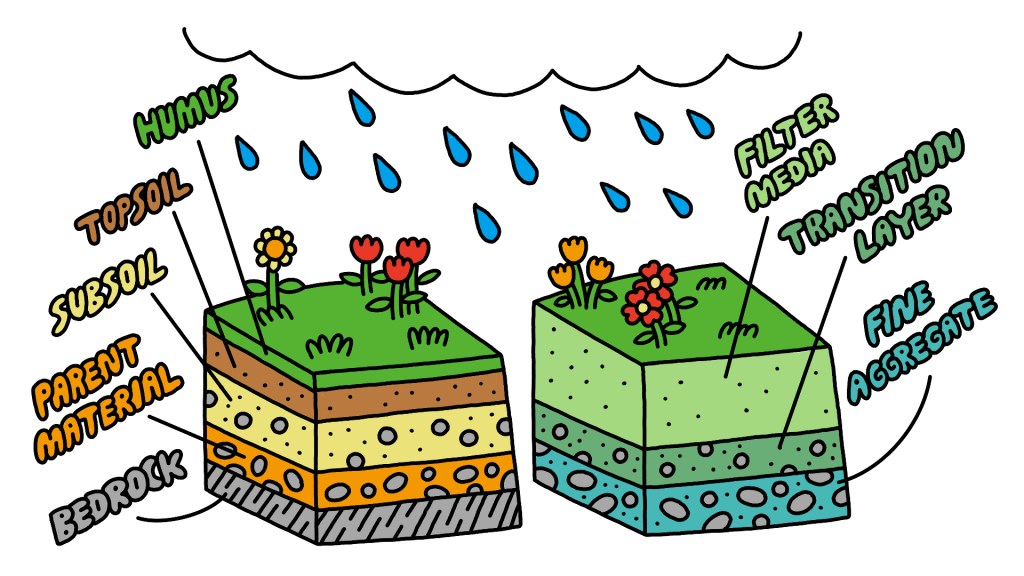
Biofiltration is the process of capturing stormwater runoff and using designed soils and vegetation to treat the captured stormwater. The bioretention cells are shallow, vegetated depressions that capture and concur stormwater runoff and allow it to infiltrate into the underlying soils. When designing a bioretention cell, it'due south important to call back about the filtration medium and underlying soils being used, and the size of the pollutant beingness filtered. Types of bioretention cells include bioswales, rain gardens, and detention ponds. Components of infiltration arrangement pattern are h2o storage, pollution treatment, and infiltration.
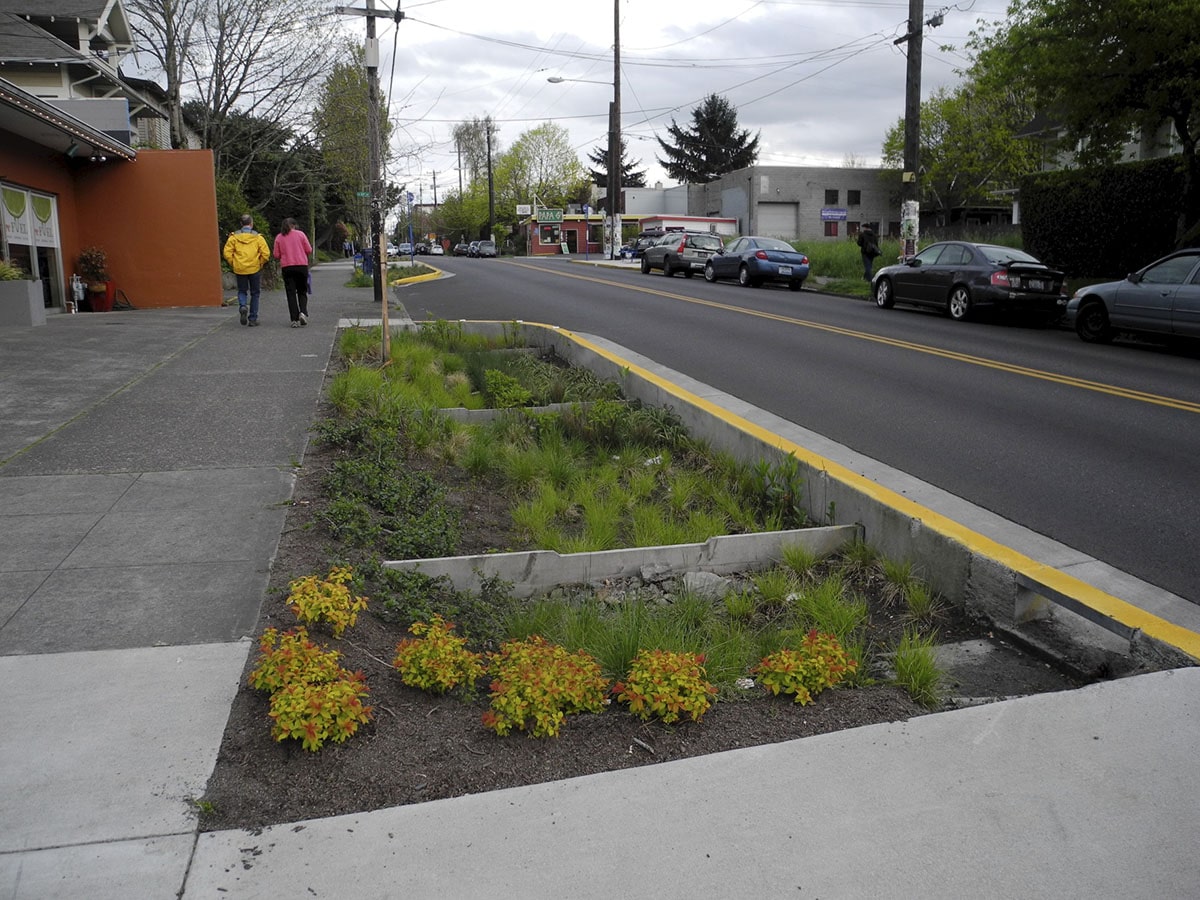
In typical bioretention cells, h2o flows laterally and vertically. The model y'all created focused on only the vertical movement of runoff and its contents within a bioretention cell. In a typical bioinfiltration system, water runs off from a drainage area (like a parking lot) and into the bioretention cell where it infiltrates, and filters out pollutants before they are discharged into a nearby waterway. The system is designed to capture those pollutants and let them to pause down over time, but some microplastics don't break downwardly and are discharged with the outflowing water.
It is of import to blueprint solutions to treating stormwater runoff that ensures they take limited effects on the environs. Currently, almost biofiltration systems are not designed to filter out microplastics, assuasive them to belch those plastics along with the treated water. When bioretention cells don't effectively remove microplastics coming from tires, clothing, and single-utilise plastics, effluent containing those microplastics can exist discharged into the nearest waterway and affect marine life.
 This resource is function of Science Fri's Educator Phenomena Forum and was developed collaboratively by Chenille Williams, an educator at the Richland County Department of Public Works, and Timnit Kefela, a Ph.D. candidate at Academy California Davis specializing in microplastics pathways. Click hither for a binder of classroom resources.
This resource is function of Science Fri's Educator Phenomena Forum and was developed collaboratively by Chenille Williams, an educator at the Richland County Department of Public Works, and Timnit Kefela, a Ph.D. candidate at Academy California Davis specializing in microplastics pathways. Click hither for a binder of classroom resources.
Chenille Williams focuses on education about the proper ways to reduce stormwater pollution, including microplastics from illegally dumped tires and single-apply plastics. We tin help reduce the number of microplastics in the water by reducing our use of unmarried-use and other plastic products. While Chenille works on stopping plastics from the source (usa), Timnit Kefela is looking at the way microplastics are either broken down, adsorbed to the soil in bioretention cells, or discharged into a nearby water body. Through her work, we can design a more efficient biofiltration arrangement to keep microplastics out of waterways.
Additional Resources
- Want to learn more about soil and how it functions? Effort Soil Engineering!
- Check out more plastics information and advocacy with the Five Gyres Institute.
- Make a Water Filter
- Abode Biofilters for Food Removal
Side by side Generation Science Standards
This resource works toward the post-obit performance expectations:
- MS-ESS3-3: Apply scientific principles to design a method for monitoring and minimizing a human impact on the environment.
- HS-ESS3-four: Evaluate or refine a technological solution that reduces impacts of man activities on natural systems.
Credits:
Written by Chenille Williams
Edits by Abigail Holstein and Xochitl Garcia
Advice and Review Timnit Kefela
Digital Production by Xochitl Garcia
Meet the Writers
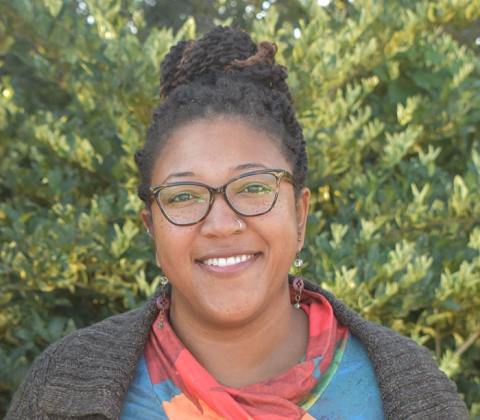
Almost Chenille Williams
Chenille H. Williams is the education programme coordinator for Richland County Stormwater Management in Columbia, South.C., she teaches students, professionals, educators, and homeowners well-nigh h2o quality problems and how to forestall surface h2o pollution through a blend of workshops, presentations, and community partnerships. Outside of being an educator, Chenille is a visual artist and loves learning about the fermentation process of kombucha.

About Timnit Kefela
@timisneat
Timnit Kefela is a PhD candidate at the Academy of California, Santa Barbara's Bren Schoolhouse of Environmental Science & Management, where she is focused on understanding the sources, pathways and fates of plastics in urban soil and marine environments. She is besides a co-organizer for Black in Environment Week, which will exist happening April xviii-22, 2022.
Explore More
This Is Plastiglomerate
Plastic is melding with marine debris in Hawaii.
Read More
Can Microplastics Be Filtered Out Of Water,
Source: https://www.sciencefriday.com/educational-resources/microplastic-filtration/
Posted by: robersonbles1976.blogspot.com


0 Response to "Can Microplastics Be Filtered Out Of Water"
Post a Comment